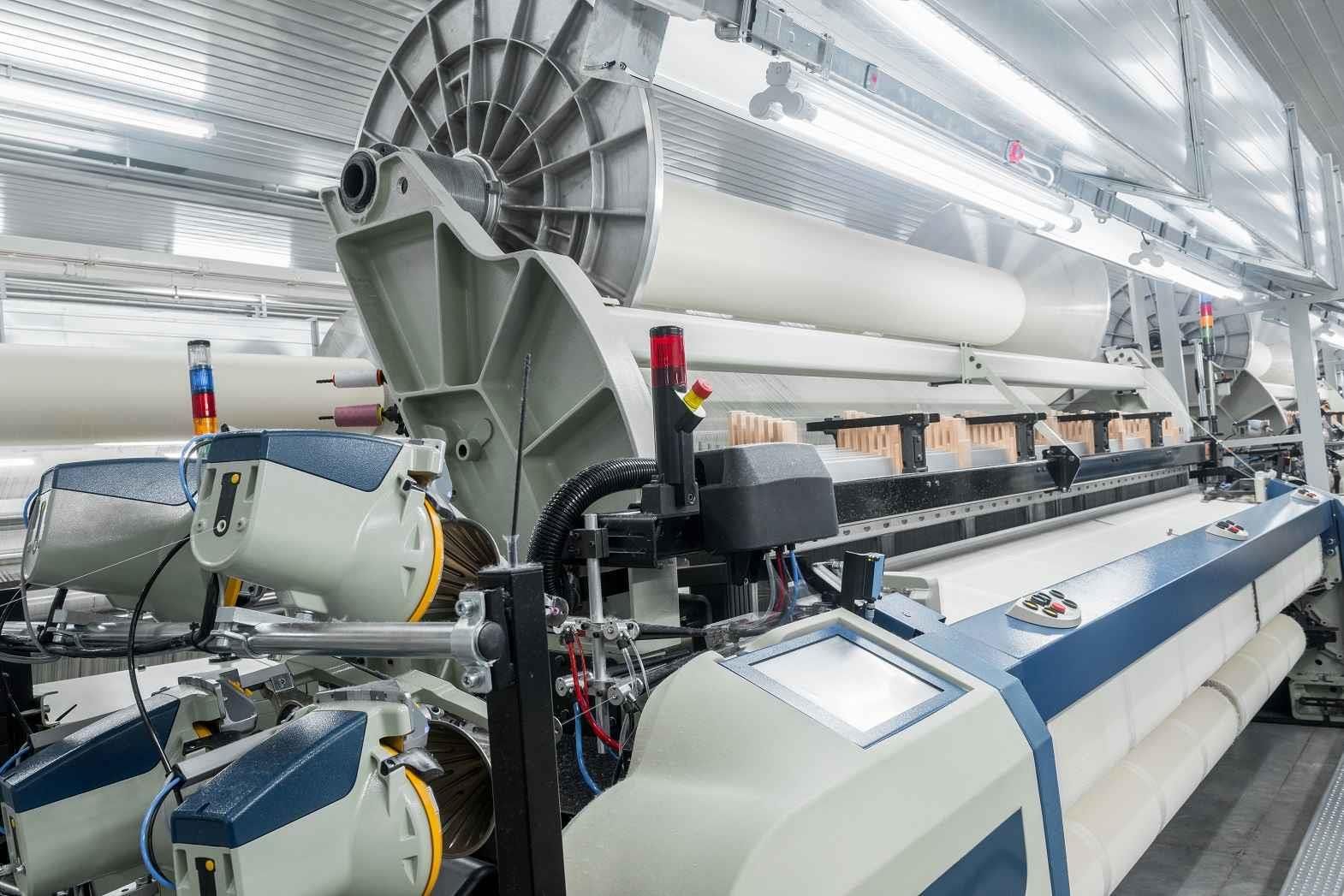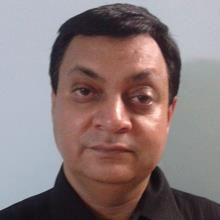Introduction
The basic mechanism in any type of loom can be classified as mentioned below:
Primary Motions:
Secondary Motions:
Auxiliary Motions:
In modern looms, we are achieving better efficiency with good productivity because provisions are given with Microprocessor based controls so weaving team can analyze following details in time and action prevents the losses at Grey stage.
MODERN LOOMS WITH DIFFERENT WEFT INSERTION SYSTEM:
1.Projectile Technology:
D 1 & D2 is the standard steel projectiles with small and large Grippers for the majority of commercial yarns. Recently a company introduced K 3 as synthetic
(Carbon Composite) projectile which has been used for economic production of very delicate fabrics.
The picking and the projectile units are separated from the moving sley. The Sley (Projectile track) carries the Reed and Gripper Guides. The gripper projectile, made of the fine steel 90 mm long, 14 mm wide and 6 mm thickness which carries the weft thread in to the warp shed. The weft is drawn directly from a large stationary cross wound package with or without accumulator. The gripper projectile is picked across the warp shed at the very high speed, the picking energy being derived from the energy stored in the metal torsion bar which is twisted at predetermined amount and released to give the projectile at high rate of acceleration. Picking always takes place from one side but several projectiles are working on conveyor chain located underneath the warp shed.
2. Rapier (Flexible & Rigid) Technology:
For Technical Textiles, we have Dornier Rigid Rapier Looms for Technical Fabrics like Glass, Aramid, Carbon ( 3 K to 50 K ) Varieties. Warp preparation is being carried out on Sectional Warping and Texmer Direct Creel to Loom. We are developing prototypes of Leno Fabric, Glass Rovings, HDPE fabrics, PPGL Matrix, PP Filter Fabrics, Jute, Ceramic Insulation Fabrics, etc. in different weaves on Dornier Rigid Rapier looms. We are running three width of 300 Tex Glass Roving together to take advantage in production of wider, width weaving machine.
For Carbon fibre weaving, Direct Texmer "creel to loom" weaving takes place. Weaving of Carbon needs precautionary measures for human health, so team members are using protective uniform with safety mask and eye covering glasses.
3. Water Jet Weaving Technology:
Water jet looms were used in early 80's for economic and bulk production of Polyester Sarees and Dress Materials, Shirting, etc. Mostly water jet looms were manufactured from Japan. These looms are suitable for medium to fine Denier Polyester yarns while Cotton and Viscose weaving was not possible with commercial acceptance.
4. Air Jet Weaving Technology:
A successful weaving technology for medium to coarse cotton and spun yarns with the mechanism of air jet picking was introduced by Max Paboo of Sweden in 1958. A leno selvedge with a fringe of about 1/8 inch or 0.33 cm length is produced during weaving. These looms have been installed in large numbers due to high RPM and better productivity controls with the help of Microprocessor based controls.
Denim and Bottom Weights, PV dress Materials, Polyester Dress Materials, Cotton Shirting, etc., are easily maintaining an installed efficiency up to 90% with good quality of woven fabric in Weaving Mills of 200 to 400 Air Jet Looms capacity. Limiting Factor in air jet weaving is requirement of Skilled Weavers, Yarn Quality, Humid Conditions and loom Settings up to accuracy advised by machine suppliers.
Control on leakages for compressed air makes bulk production with economic World Class Manufacturing.
5. Multiphase Weaving Technology:
Multiphase weaving machine is one in which several phases of the weaving cycle takes place at any instant such that several filling yarns can be inserted simultaneously. In this mechanism, more than one weaving shed is formed at a time. The Multiphase can weave 190 cm width with 69 meters of fabric per hour. Manufacturers of these weaving machines are Switzerland and Russia. Application of these fabrics is in Geo Textiles and Awnings.
6. Multi Axial Weaving Technology:
In recent years multi axial fabrics have begun to find favour in the construction of composite components. These fabrics consist of one or more layers of long fibres held in place by a secondary non-structural stitching thread. The main fibres can be any of the structural fibres available in any combination. The stitching thread is usually polyester due to its combination of appropriate fibre properties.
The most common forms of this type of fabric are shown in the following diagrams:
There are two basic ways of manufacturing multi-axial fabrics:
Weave & Stitch
With the 'Weave & Stitch' method the 45 and -45 layers can be made by weaving weft unidirectional and then skewing the fabric, on a special machine to 45. A warp unidirectional or a weft unidirectional can also be used unskewed to make a 0 and 90 layer. If both 0 and 90 layers are present in a multi-layer stitched fabric then this can be provided by a conventional 0/90 woven fabric. Due to the fact that heavy rovings can be used to make each layer the weaving process is relatively fast, as is the subsequent stitching together of the layers via a simple stitching frame.
To make a quadraxial (four-layer: 45, 0, 90, -45) fabric by this method, a weft
unidirectional would be woven and skewed in one direction to make the 45 layer, and in the other to make the -45 layer. The 0 and 90 layers would appear as a single woven fabric. These three elements would then be stitched together on a stitching frame to produce the final four-axis fabric.
7. Weaving Machines & Embroidery Unit:
Machinery has been introduced recently with a new dimension for pattern on Weaving Machines:
Air jet weaving machine with embroidery unit
Rapier weaving Machine with embroidery unit
The ORW (Open Reed Weave) technology allows wide diversity in pattern for clothing and decorative fabrics or specially applied reinforcements in technical textiles.
8. Needle Weaving Technology for Narrow Fabrics & Ropes:
Narrow looms technology is introduced by Jakob Muller, Switzerland. Woven Ropes and Belts are better in Tensile Strength compared to conventional products.
Training & Maintenance:
During new installation of modern weaving machines training by experienced erectors or trainers deputed by manufacturer is essential. For achieving best result in terms of optimum productivity, we should follow the Maintenance and Lubrication schedule thoroughly.
Conclusion:
Selection of the loom depends upon the type of textile material that has to be woven.
Furthermore, the versatility of the loom is an important factor so that majority of the
fabrics can be woven as per the ever-changing requirement and trend of the market.
Mostly the looms are equipped with microprocessor based controls. Analyzing their data and taking timely actions will result in optimum productivity. The performance of the modern looms is not deteriorated by its long term usage till its' Scheduled maintenance and lubrication is done properly.
References:
1) Weaving Mechanism Vol. 2 by Prof. N N Banerjee
2) World Class Manufacturing by Kamalakar Mutalik, Symbiosis, Pune
3) Indian Textiles 2015 by Jay Narayan Vyas
4) Handbook of weaving by Sabit Adanur
5) Weaving: Machines, Mechanisms, Management by Talukdar and Ajgaonkar
6) Tsudakoma.co.jp/
7) Toyota-industries.com/product/textile/textile/textile.html
8) Lindauerdornier.com/en/weaving-machine
9) Mueller-frick.com/
10) Itemagroup.com
11) Biteam.com/press/first-industrial-3d-weaving-machinedeveloped.
12) Karlmayer.com/internet/en/textilmaschinen/963.jsp
13) Liba.de/pages/de/startseite.php
Mr. Pradeep Kulshrestha is Head of Incubation Centre , Ahmedabad Textile Industry's Research Association (ATIRA)








Comments